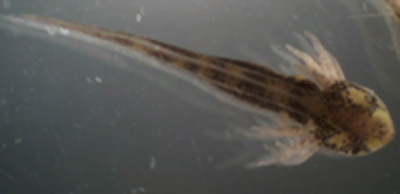From the various microsurgical procedures of Spemann and others, several developmental principles have emerged about amphibian embryos. One of the most important discoveries was the understanding that the developmental fates of various groups of cells are not rigidly determined early in development. In many cases, if a multicellular fragment of an early frog gastrula is transplanted from one region of the embryo to another, the cells will behave as if they were cells from the inserted site, producing structures that would normally develop in that part of the embryo.
Later in development, however, cells of transplanted fragments develop differently. They tend to continue along the same developmental pathways that they would have followed in their original location. They differentiate as if they had not been transplanted, thus producing an anomalous patch of misplaced tissue.
Experiments by DuShane in the 1930s revealed that the neural crest elements are precursors of pigment cells. To demonstrate that the pigment cells are derived from the neural crest, we plan to transplant the crest material to another region of the frog's body. Neural crest cells form a dorsally placed wedge between the lateral wall of the neural fold and the ectoderm on each side of the embryo, thus the removal of the lateral neural fold removes a portion of the neural crest.

A young axolotl embryo.
Objective
In this experiment we will transplant neural crest elements from one embryo into the ventral surface of another embryo and observe how the transplantation effects the development of the embryo. Because pigment cells develop from the neural crest region, a successful transplantation would result in a group of pigment cells arising where the neural crest cells are transplanted to. Finally we will observe whether the donor embryo can recover from the surgery and still make the neural crest after we have removed the lateral neural tube.

An axolotl embryo, an example of what was used in this lab.
Protocol
I. Preparation of Microsurgery Tools
Follow protocol found on the general protocol web page.
II. Microsurgery preparation:
1. Manually dejelly embryo of stage 14 and keep in HSBt containing antibiotics until use. For microsurgery, also remove membrane around the embryo.
2. Prepare 2% agarose-coated operating dish. Rinse with HBSt and antibiotics.
3. Place embryos into operating dish containing 1X HBSt and antibiotics.
4. Use clean technique while performing microsurgery (i.e. dip all tools, pipettes, and glass bridges into 70% ethanol and then into sterile HBSt before using).
III. Transplantation of the neural crest
1. Prepare a small pocket in the ventral surface of the host embryo. Only a slit is required by cutting with a glass needle. The pocket can be enlarged to receive the transplant by carefully removing some of the mesoderm cells with the tip of the glass needle.
2. Using a fine-tipped needle, remove part of the neural fold on the right side of the embryo. With a single motion from the anterior to the posterior, use the glass needle to make a thin tear in the pigmented epidermis very close to the outer edge of the right neural fold. Now, tear carefully through the whitish mesodermal cells that lie underneath. When the grayish-tan endodermal cells become visible, stop cutting. Follow the first longitudinal cut with a second parallel cut at the inner edge of the right neural fold. Next, make two transverse cuts, anterior to posterior, to complete a rectangular area of neural fold tissue.
3. Lift the entire rectangular area of neural tissue away from the embryo with the tip of the glass needle. The piece should include a whitish mesoderm with the overlying pigmented ectoderm.
4. Transfer the neural fold transplant on the tip of the glass needle to the ventral pocket on the recipient embryo. Gently and firmly push the whole mass through the narrow incision and anchor it against the yolk. A tight fitting transplant is desirable.
5. Quickly cover the implant with the flat surface of a piece from a thin-grade coverslip. Wait one hour.
6. Carefully remove the coverslip. If the transplant has not healed properly, place it under pressure again for another half hour. After healing is complete, transfer both the donor and the host embryos to a glass dish containing spring water.
7. Observe the differentiation of the implanted tissue. Note whether graft was successfully transplanted, how the embryo responded to the graft, and whether there have been any differences which have occurred in the development of the embryo.
Results
Twenty embryos were surgically manipulated. Of those 20, eight were deemed possibly successful transplants. However, upon checking the embryos after 48 hours, it was determined that none of the embryo successfully accepted the grafts.
Why did this happen? It was most likely because we did not possess the manual dexterity which was required to perform microsurgery on the small embryos. Additionally, the glass cover plates which were placed on top of the embryos post-surgery caused the embryos to be pulled apart after we attempted to remove them 48 hours post-op.
We feel that this lab would be better to perform with later stage embryos or by a person with the necessary dexterity to manipulate the delicate embryos.

2023年3月18日,《CellStemCell》期刊以封面文章的形式在线发表了中国科学院脑科学与智能技术卓越创新中心(神经科学研究所)、神经科学国家重点实验室陈跃军研究组题为《人神经分化过程中跨时间......
研究表明,人造光(artificiallight)是引发机体代谢紊乱的一种高风险因素,然而,光调节机体代谢背后的神经机制,目前研究人员并不清楚。近日,一篇发表在国际杂志Cell上题为“Lightmod......
虽然许多原核生物都有糖酵解的替代品,但它被认为是真核生物中唯一产生能量的葡萄糖分解代谢途径。2023年2月8日,北京化工大学JensNielsen与刘子鹤共同通讯在Cell 在线发表题为”F......
载脂蛋白E的三种亚型(APOE2,APOE3和APOE4)仅在两个氨基酸位置上存在差异,但其免疫调节作用却截然不同。这种APOE亚型依赖的潜在机制仍然是谜。2023年1月2日,西湖大学施一公团队在Ce......
骨骼肌是执行机体运动功能的主要组织器官之一。与衰老相关的骨骼肌质量和功能减退被称为肌肉减少症(Sarcopenia,肌少症),这种疾病将导致老年人运动能力、平衡能力等身体机能的显著下降骨骼肌是执行机体......
衰老,是一个复杂、多阶段、渐进的过程,发生在生命的整个过程。随着时间的流逝,人体的器官、肌肉会逐渐衰老,一些疾病也伴随着年龄的增长而发生,包括癌症、糖尿病、心血管疾病等。 近几年......
在一项新的研究中,来自美国怀特海德研究所和布罗德研究所的研究人员利用一种新颖的、集合的、基于成像的筛选方法系统性地评估了5000多个人类必需基因的功能。他们的分析利用CRISPR/Cas9来敲除基因活......
“我们没有用到精子、卵子和子宫,仅用干细胞就培育出了合成小鼠的胚胎模型。”一篇发表在Cell上的论文,这两天简直火出圈了,起因就是作者JacobHanna介绍论文时说的这番话。从实验结果来看,合成的胚......
目前全世界有数以亿计的男性,女性甚至是儿童饱受脱发困扰,遗传、衰老、分娩、癌症治疗、烧伤以及压力等都可能导致脱发。脱发虽然不会造成严重的健康问题,但是因为影响美观,会导致个人形象问题,并因此带来情绪创......
2022年6月15日,天津医科大学刘强团队(天津医科大学为第一单位)在Cell 在线发表题为“Bonemarrowhematopoiesisdrivesmultiplesclerosispr......